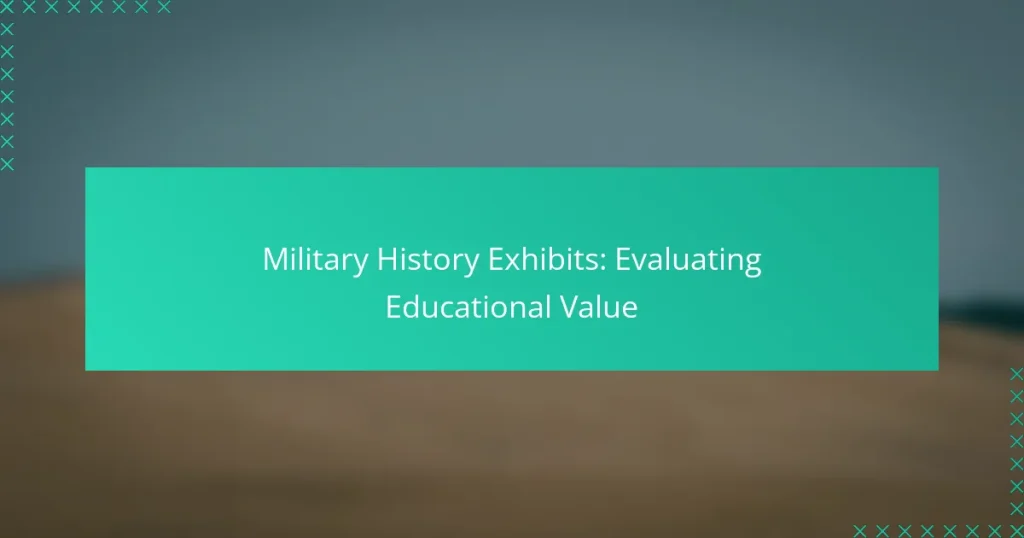Military history exhibits play a crucial role in educating the public about past conflicts and their lasting effects on society. By employing interactive displays and guided tours, these exhibits enhance visitor engagement and comprehension, making complex historical events more accessible and relatable. Notable institutions like the National WWII Museum and the Smithsonian National Museum of American History offer immersive experiences that deepen understanding of significant military events and figures.
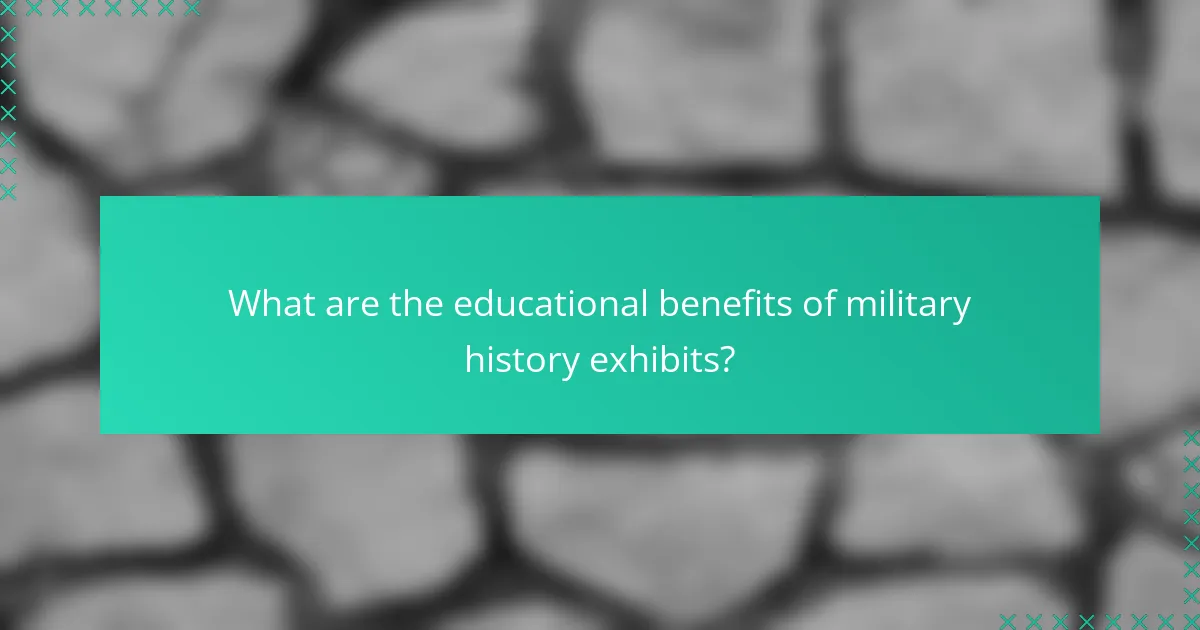
What are the educational benefits of military history exhibits?
Military history exhibits provide significant educational benefits by enhancing knowledge of past conflicts and their implications. They serve as valuable resources for understanding the complexities of warfare, the experiences of soldiers, and the broader societal impacts of military actions.
Enhanced understanding of historical events
Military history exhibits offer detailed narratives and artifacts that illuminate key historical events. Visitors can explore timelines, maps, and personal accounts that bring to life the causes and consequences of wars. For example, an exhibit on World War II might include original documents, uniforms, and multimedia presentations that contextualize the conflict within global history.
By engaging with these exhibits, individuals can gain a deeper appreciation for the factors that shaped military strategies and outcomes. This understanding can foster a more nuanced view of history, moving beyond simplistic narratives to recognize the complexities involved.
Promotion of critical thinking skills
Engaging with military history exhibits encourages critical thinking by prompting visitors to analyze various perspectives and motivations behind historical events. Exhibits often present conflicting viewpoints, allowing individuals to evaluate the reliability of sources and the biases inherent in historical narratives.
For instance, an exhibit may juxtapose official military accounts with personal diaries from soldiers, challenging visitors to consider the impact of perspective on historical interpretation. This analytical approach not only enhances historical understanding but also sharpens overall critical thinking skills applicable in various contexts.
Engagement with diverse perspectives
Military history exhibits frequently highlight diverse perspectives, including those of soldiers, civilians, and marginalized groups affected by conflict. This engagement helps to create a more comprehensive understanding of history, as it reflects the multifaceted nature of warfare and its consequences.
For example, an exhibit might feature narratives from both combatants and non-combatants, illustrating the varied experiences during a specific conflict. By presenting these different viewpoints, exhibits foster empathy and encourage discussions about the broader implications of military actions on society.
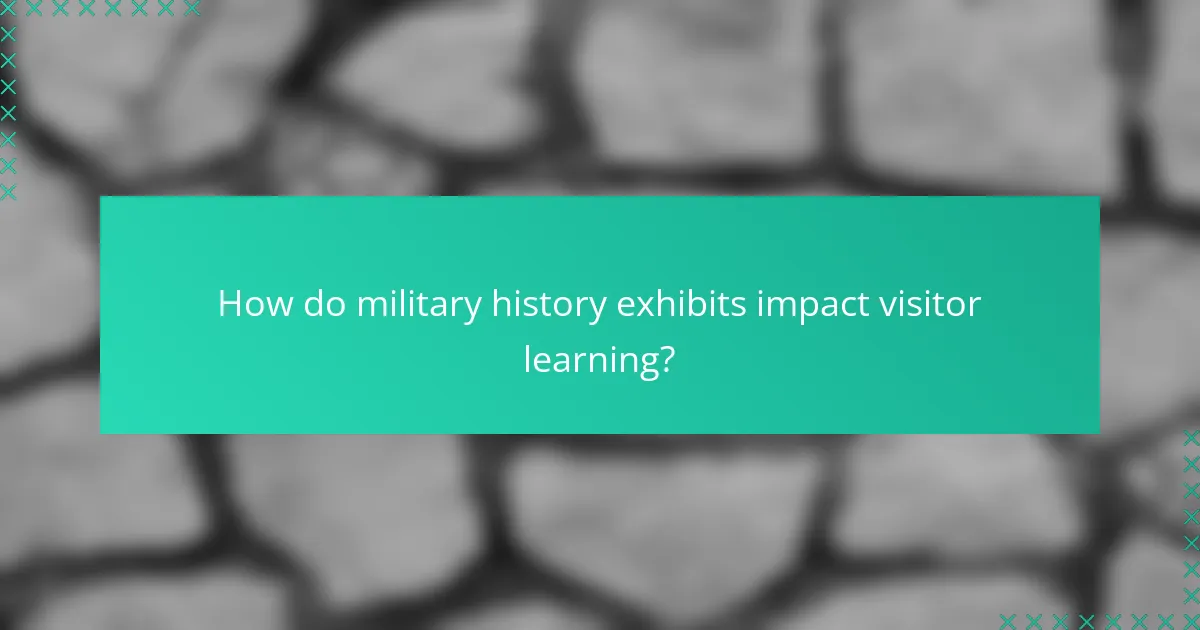
How do military history exhibits impact visitor learning?
Military history exhibits significantly enhance visitor learning by providing engaging and informative experiences that foster understanding of historical events. These exhibits utilize various methods, such as interactive displays and guided tours, to promote deeper retention and comprehension of military history.
Interactive displays increase retention
Interactive displays, such as touchscreens and hands-on exhibits, allow visitors to engage directly with the material, which can lead to improved retention of information. By involving multiple senses, these exhibits create memorable experiences that encourage exploration and curiosity.
For example, a virtual reality simulation of a historical battle can immerse visitors in the environment, making the learning experience more impactful. Research suggests that interactive elements can boost retention rates by significant margins, often exceeding traditional display methods.
Guided tours provide expert insights
Guided tours led by knowledgeable experts offer visitors unique insights into military history that self-guided experiences may lack. These tours often include anecdotes, contextual information, and answers to questions, enriching the learning experience and fostering a deeper understanding of the subject matter.
When participating in a guided tour, visitors can engage in discussions and ask questions, which helps clarify complex topics. This interaction can enhance learning outcomes, making guided tours a valuable complement to static exhibits in military history museums.
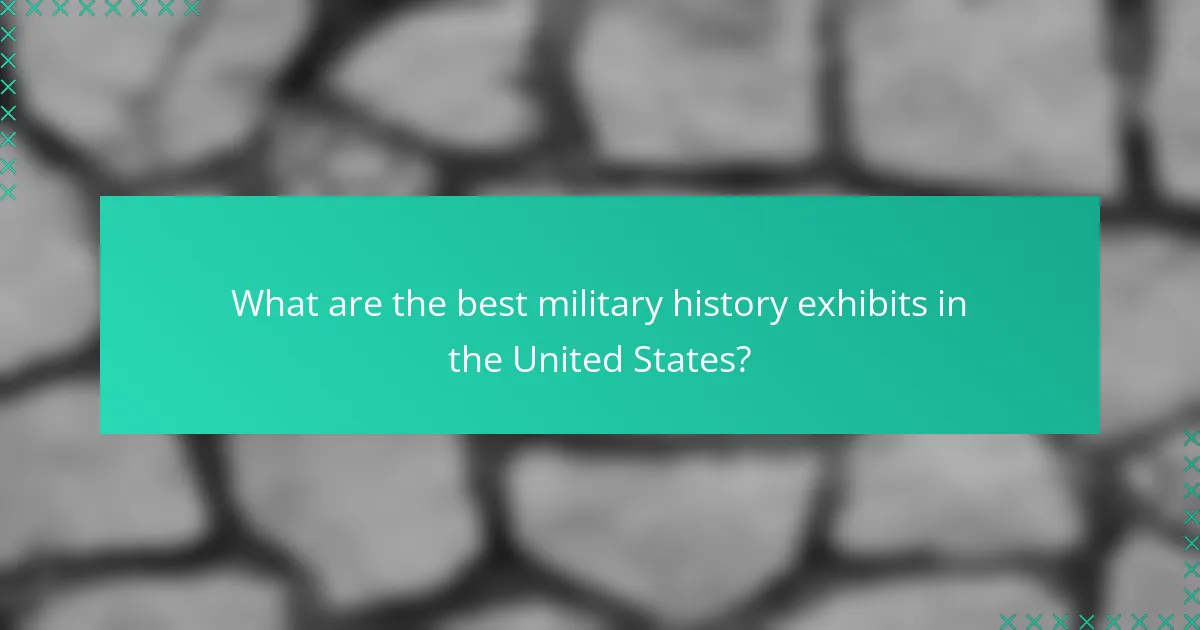
What are the best military history exhibits in the United States?
The best military history exhibits in the United States offer immersive experiences that educate visitors about significant events and figures in military history. Key locations include the National WWII Museum, the Smithsonian National Museum of American History, and the U.S. Army Museum, each providing unique insights and artifacts.
National WWII Museum in New Orleans
The National WWII Museum is renowned for its comprehensive portrayal of the American experience during World War II. It features engaging exhibits, including personal stories, artifacts, and multimedia presentations that bring history to life.
Visitors can explore various galleries, such as the “Road to Berlin” and “Road to Tokyo,” which detail the military campaigns in Europe and the Pacific. The museum also hosts educational programs and events that enhance understanding of the war’s impact.
Smithsonian National Museum of American History in Washington, D.C.
The Smithsonian National Museum of American History offers extensive military history exhibits that highlight the role of the U.S. military in shaping the nation. Key artifacts include uniforms, weapons, and documents that illustrate pivotal moments in American military history.
One of the museum’s notable displays is the Star-Spangled Banner, which connects visitors to the War of 1812. The museum also provides interactive experiences that encourage deeper engagement with historical narratives.
U.S. Army Museum in Fort Belvoir
The U.S. Army Museum at Fort Belvoir focuses on the history and heritage of the U.S. Army, showcasing its evolution from the Revolutionary War to the present day. The museum features a variety of exhibits, including vehicles, weapons, and personal stories from soldiers.
Visitors can participate in guided tours that provide insights into the Army’s role in various conflicts and peacekeeping missions. The museum also emphasizes the importance of understanding military history in the context of current events.

How can educators utilize military history exhibits?
Educators can effectively utilize military history exhibits to enhance students’ understanding of historical events and their significance. By integrating these exhibits into teaching strategies, educators can foster engagement and critical thinking about military history.
Field trips to enhance curriculum
Field trips to military history exhibits provide students with firsthand experiences that textbooks cannot replicate. Visiting museums or battlefields allows learners to engage with artifacts and displays, making history tangible and relatable.
When planning a field trip, consider logistics such as transportation costs, entry fees, and available educational programs at the site. Many military museums offer guided tours or workshops tailored for school groups, which can enrich the learning experience.
Incorporating exhibits into lesson plans
Incorporating military history exhibits into lesson plans can deepen students’ understanding of specific topics. For example, after a visit, educators can assign projects where students research artifacts they encountered, encouraging them to connect personal stories to larger historical narratives.
Utilize multimedia resources from the exhibits, such as videos or interactive displays, to create engaging lesson materials. Additionally, consider using primary sources from the exhibits to teach critical analysis skills, helping students evaluate different perspectives on military history.
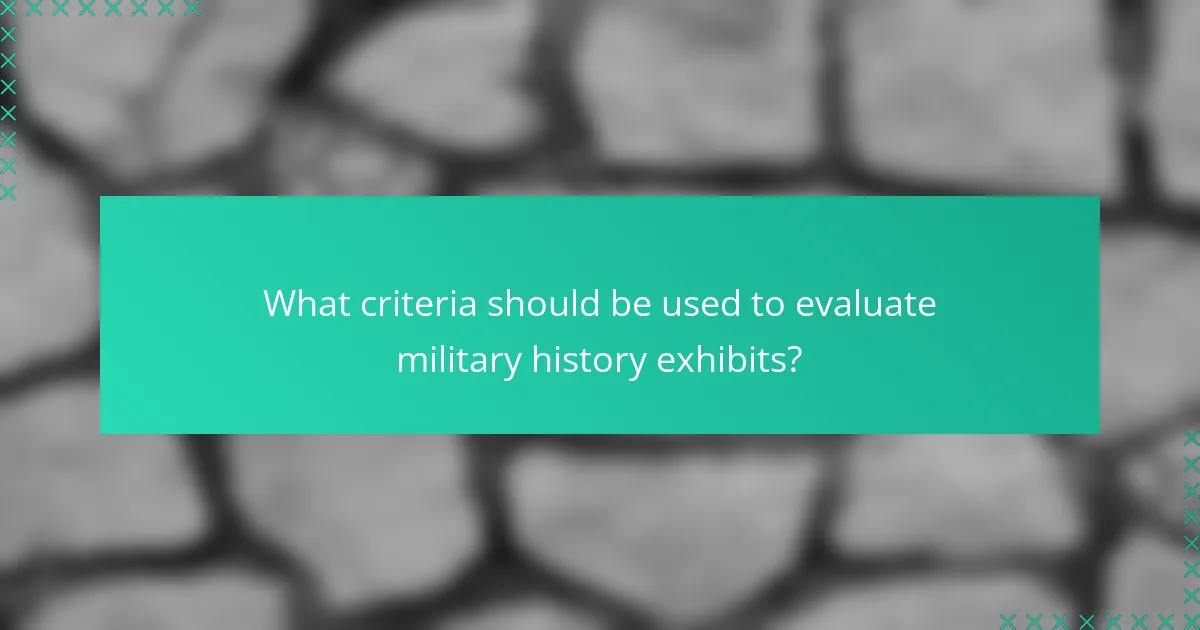
What criteria should be used to evaluate military history exhibits?
To evaluate military history exhibits effectively, consider criteria such as their relevance to educational standards, the quality of artifacts and displays, and the overall visitor engagement. These factors help determine how well the exhibit meets educational goals and enhances understanding of military history.
Relevance to educational standards
Exhibits should align with local and national educational standards to ensure they provide valuable learning experiences. For example, in the United States, they may need to connect with history curriculum benchmarks set by the Department of Education.
When assessing relevance, consider whether the exhibit addresses key historical events, figures, and themes that are part of the educational framework. This alignment can enhance the exhibit’s effectiveness in teaching students and engaging educators.
Quality of artifacts and displays
The quality of artifacts and displays is crucial for creating an impactful exhibit. Authenticity, condition, and historical significance of the items displayed can greatly influence visitor interest and educational value. High-quality artifacts should be well-preserved and accurately labeled to provide context.
Additionally, the design of the display plays a significant role. Effective use of space, lighting, and multimedia elements can enhance the storytelling aspect of the exhibit. Consideration should be given to how these elements work together to create an immersive experience that captivates visitors.
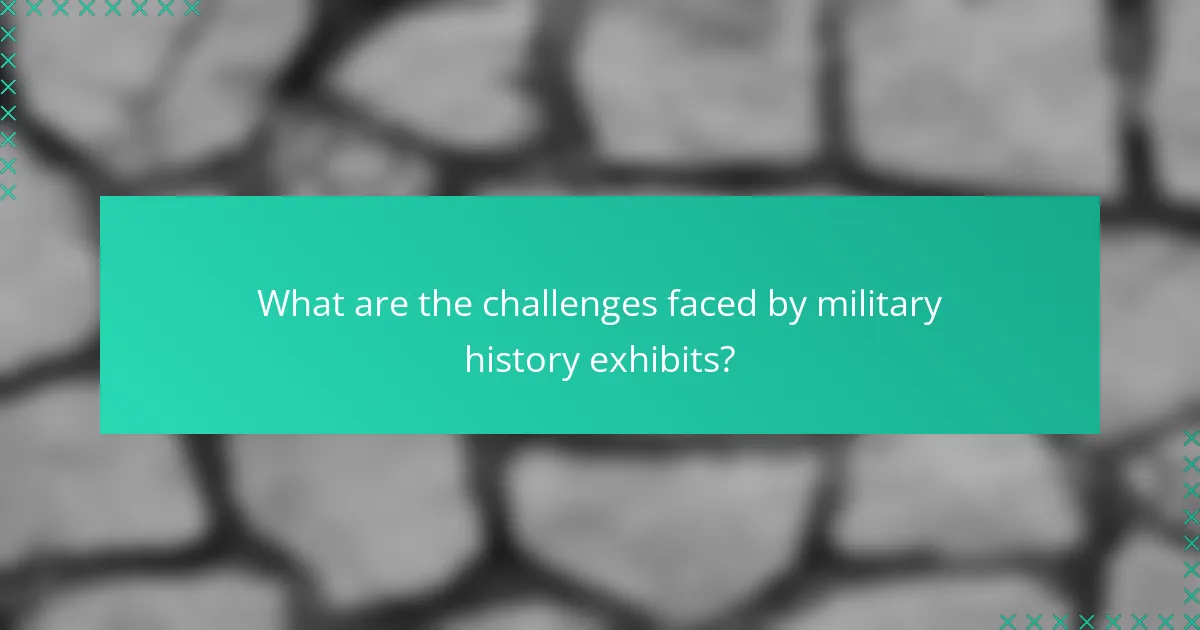
What are the challenges faced by military history exhibits?
Military history exhibits encounter several challenges that can impact their educational value. Key issues include securing adequate funding and resources, as well as maintaining visitor engagement throughout the exhibit experience.
Funding and resource allocation
Funding is a critical challenge for military history exhibits, often determining the scope and quality of the display. Many institutions rely on a mix of government grants, private donations, and ticket sales, which can fluctuate significantly.
Resource allocation also plays a vital role; museums must decide how to distribute limited funds among various needs such as exhibit design, educational programming, and preservation of artifacts. Prioritizing these areas can greatly influence the overall visitor experience.
Maintaining visitor engagement
Engaging visitors in military history exhibits requires innovative approaches to storytelling and interactivity. Traditional displays may not capture the attention of younger audiences, prompting the need for multimedia elements or hands-on activities.
Exhibits should incorporate diverse learning methods, such as guided tours, interactive kiosks, and virtual reality experiences, to cater to different learning styles. Regularly updating exhibits with new content or themes can also help sustain interest and encourage repeat visits.
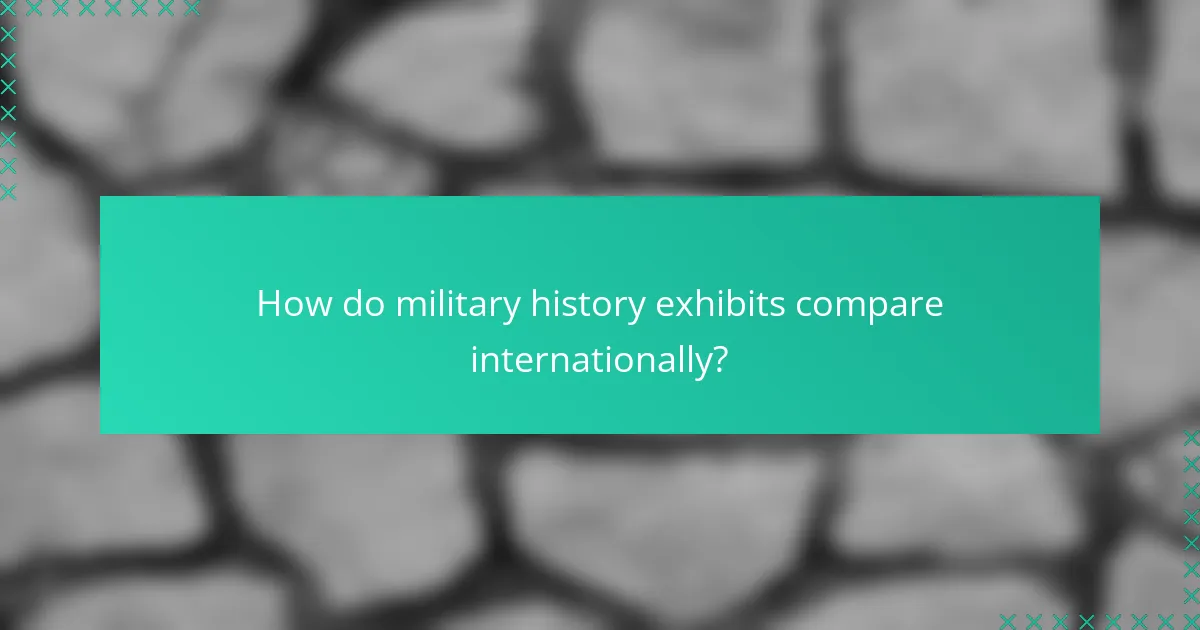
How do military history exhibits compare internationally?
Military history exhibits vary significantly across countries in terms of educational value, presentation styles, and visitor engagement. While some nations prioritize immersive experiences, others focus on traditional displays of artifacts and information.
Exhibit Design and Engagement
Exhibit design plays a crucial role in how military history is presented and perceived. Countries like Germany and the United States often use interactive elements, such as virtual reality and hands-on displays, to engage visitors. In contrast, some nations may rely more on static displays, which can limit visitor interaction but still provide valuable historical context.
For example, the Imperial War Museum in London features immersive experiences that allow visitors to engage with history actively, while many smaller museums may present artifacts with less interactivity. This difference can affect how effectively the exhibits educate the public about military history.
Educational Approaches
Educational approaches to military history exhibits can differ widely. In countries like Canada, there is a strong emphasis on including diverse perspectives, such as the experiences of Indigenous peoples and women in the military. This inclusive approach can enhance the educational value by providing a more comprehensive view of history.
Conversely, some nations may focus primarily on military achievements and battles, potentially overlooking the broader social implications. Visitors should consider the educational philosophies behind the exhibits to gauge their depth and relevance.
Visitor Experience and Accessibility
Visitor experience and accessibility are key factors in the effectiveness of military history exhibits. In countries such as Australia, many museums prioritize accessibility by offering guided tours, audio guides, and materials in multiple languages. This inclusivity can significantly enhance the educational experience for diverse audiences.
On the other hand, some international exhibits may lack these features, making it difficult for certain groups to fully engage with the content. When evaluating military history exhibits, consider the availability of resources that cater to various visitor needs to ensure a well-rounded educational experience.
